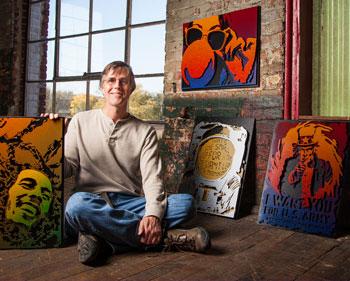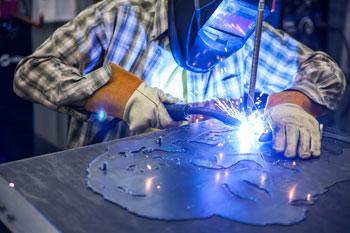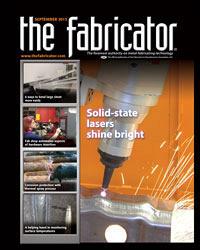- FMA
- The Fabricator
- FABTECH
- Canadian Metalworking
Categories
- Additive Manufacturing
- Aluminum Welding
- Arc Welding
- Assembly and Joining
- Automation and Robotics
- Bending and Forming
- Consumables
- Cutting and Weld Prep
- Electric Vehicles
- En Español
- Finishing
- Hydroforming
- Laser Cutting
- Laser Welding
- Machining
- Manufacturing Software
- Materials Handling
- Metals/Materials
- Oxyfuel Cutting
- Plasma Cutting
- Power Tools
- Punching and Other Holemaking
- Roll Forming
- Safety
- Sawing
- Shearing
- Shop Management
- Testing and Measuring
- Tube and Pipe Fabrication
- Tube and Pipe Production
- Waterjet Cutting
Industry Directory
Webcasts
Podcasts
FAB 40
Advertise
Subscribe
Account Login
Search
Metal portraits that pop
People and metal serve as three-dimensional artist’s muse
- By Amanda Carlson
- September 5, 2013
- Article
- Arc Welding

Metal artist Alan Derrick doesn’t confine his 3-D metal pop art portraits to celebrities; he also captures the likenesses of political and historical figures and events.
Metal artist Alan Derrick of Gurley, Ala., has had the urge to work with metal ever since he was a young man tinkering in his parents’ garage. The 20-year veteran of the construction industry has always been drawn to the artistic side of things and even found his knack for creativity useful on the job. Even though he enjoyed his construction job, metalworking never left his blood.
“Fabricating with metal is much more challenging than fabricating with wood. It was the challenge that drew me back.”
Derrick got the itch to “putter around his garage” in 2001. At that time he purchased a lathe, a milling machine, an automotive paint spray gun, and a few welding power sources and made larger-than-life bird feathers that were anywhere from 2 to 9 ft. tall. He hand cut each one and sold them through art galleries. In 2008, just as his feathers gained traction in the fine art community, the economy collapsed.
“Galleries started going out of business and things stopped selling. I had a couple of people working for me at the time, so I had to let them go and re-evaluate what I was doing and where I was going to go next.”
The Making of 3-D Metal Pop Art
Derrick revisited skills he acquired in Photoshop, CorelDRAW, and architectural CAD. In college he learned how to create a silhouette image from a photograph, and that led to the idea of creating 3-D portraits with multiple layers of steel. So he drew a design and cut each layer by hand using a pneumatic shear, a nibbler, or a grinder. He made koi fish, trees, and a dog and graduated to portraits of Michael Jackson and Madonna, and put them up for sale on e-Bay.
“They sold quickly, and I got good feedback, so I made some more. At that point I knew I had to do something about how I cut them out.”
After some research, Derrick purchased a CNC plasma cutting table, familiarized himself with a few new CAD programs, and got to work. He draws each layer, loads them into CAD, and cuts them separately, which can be difficult at times, especially since each layer is designed to give the illusion of a light source.
“I have to be able to visualize the top layer, the middle layer, and then the back layer all working together in color to create the illusion that I want. Sometimes I get myself a headache trying to get these things to work out. Even with all of the technology out there, sometimes it comes out in a way that I don’t like, so I’ll have to start over. A vast majority of the time I can draw these things, tweak them in the computer, and see onscreen how the layers interact with one another.”
A metal standoff—threaded cylinders—provides the ½-in. separation between each layer. Derrick carefully locates each standoff and welds it in place with gas metal arc welding (GMAW).
Once each layer is secure, he might give one of the layers a once over with a grinder to give it a textured appearance, like on “Seize the Day”. From there he takes the portrait into the spray booth and adds color, typically starting with the darker colors in the back layers and saving the lighter colors for the front. The color enhances the illusion of the perceived light source.

Derrick used gas metal arc welding (GMAW) to secure the metal standoffs to the top layer of Nelson Mandela to create the 3-D pop that makes his portraits so unique and intricate.
Tug of War
Derrick now receives requests faster than he can accommodate, and nearly every one of his portraits is met with criticism. If he portrays anyone remotely polarizing or political, President Barack Obama, for example, his motivations are questioned and criticized immediately. Even though art that generates so much passion in viewers is essentially a good thing, that’s really not Derrick’s end game.
The truth is, while he has his own political and social beliefs that he prefers to keep to himself, he is, at the heart of it all, just a guy who enjoys people and likes learning about what makes them tick. If it were up to him, he’d capture the images of everyday people who are unique, quirky, and fascinating.
“There’s this tug of war that occurs between creating the art that I want to make and creating art that people want to buy. I’ll bet I’ve never sold two copies of one of the better pieces I’ve made.”
He researches everyone he features, which gives him ideas on how to make the portrait unique to that individual, as was the case with his Nelson Mandela piece.
“I learned about how he spent 27 years in prison objecting to apartheid. If you look in the background—and it’s a lot more evident in person—there’s a big 27 sitting behind the text. I never would have done that if I hadn’t done my research.”
And as far as portrait subjects go, the sky is the limit. And a file folder at least an inch thick full of requests from customers and fans of his work means he’s got plenty to do.
About the Author

Amanda Carlson
2135 Point Blvd
Elgin, IL 60123
815-227-8260
Amanda Carlson was named as the editor for The WELDER in January 2017. She is responsible for coordinating and writing or editing all of the magazine’s editorial content. Before joining The WELDER, Amanda was a news editor for two years, coordinating and editing all product and industry news items for several publications and thefabricator.com.
subscribe now

The Fabricator is North America's leading magazine for the metal forming and fabricating industry. The magazine delivers the news, technical articles, and case histories that enable fabricators to do their jobs more efficiently. The Fabricator has served the industry since 1970.
start your free subscription- Stay connected from anywhere

Easily access valuable industry resources now with full access to the digital edition of The Fabricator.

Easily access valuable industry resources now with full access to the digital edition of The Welder.

Easily access valuable industry resources now with full access to the digital edition of The Tube and Pipe Journal.
- Podcasting
- Podcast:
- The Fabricator Podcast
- Published:
- 04/16/2024
- Running Time:
- 63:29
In this episode of The Fabricator Podcast, Caleb Chamberlain, co-founder and CEO of OSH Cut, discusses his company’s...
- Trending Articles
AI, machine learning, and the future of metal fabrication

Employee ownership: The best way to ensure engagement

Dynamic Metal blossoms with each passing year

Steel industry reacts to Nucor’s new weekly published HRC price

Metal fabrication management: A guide for new supervisors

- Industry Events
16th Annual Safety Conference
- April 30 - May 1, 2024
- Elgin,
Pipe and Tube Conference
- May 21 - 22, 2024
- Omaha, NE
World-Class Roll Forming Workshop
- June 5 - 6, 2024
- Louisville, KY
Advanced Laser Application Workshop
- June 25 - 27, 2024
- Novi, MI


























